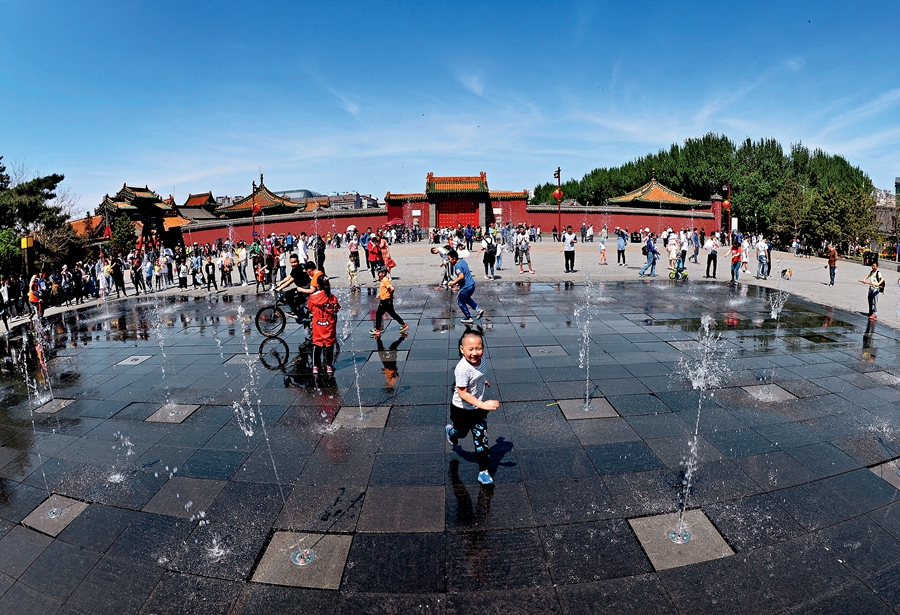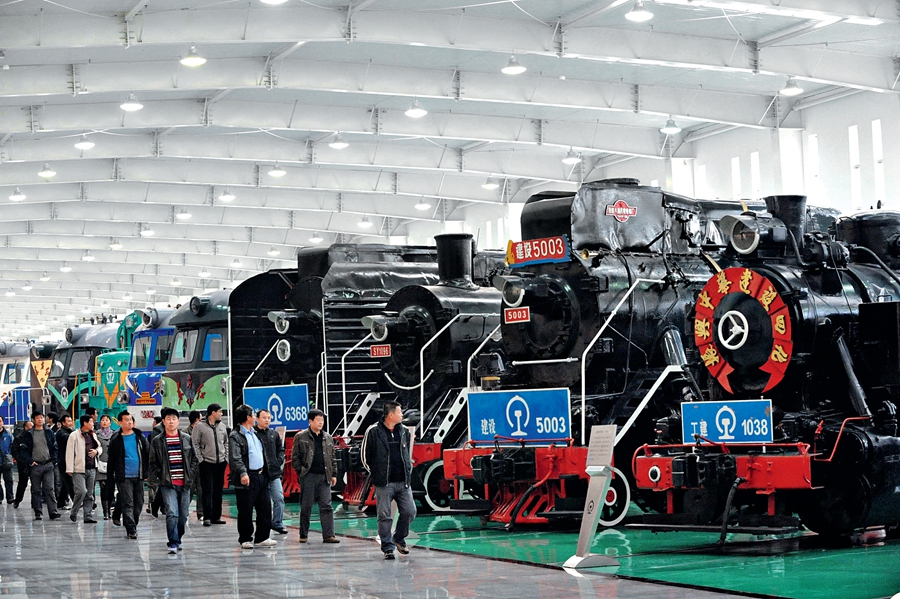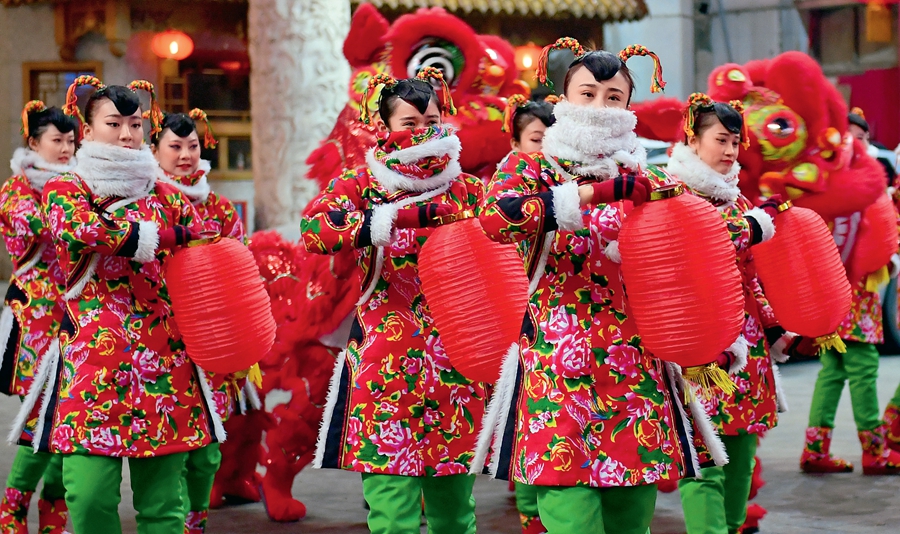THE capital of Liaoning Province, Shenyang is a key city in Northeast China and an advanced equipment manufacturing base. Nestled in the south of the Northeast China, it borders Liaodong Peninsula in the south and Changbai Mountain in the north, and is at the center of the Northeast Asia Economic Circle and the Bohai Economic Rim.

The Shenyang Palace Museum sees a spike in tourists during the 2018 Labor Day holiday.
Shenyang boasts of a glorious past. China’s last feudal dynasty set up its capital here, bestowing much historic legacy to the city. In modern times, Japan began its war of aggression against China in Shenyang, heralding the Second World War. After the founding of the People’s Republic of China, as the country’s foremost heavy industrial and equipment manufacturing base at the time, the city produced many firsts to boost national development. It manufactured China’s first machine tool, the first electromagnet, the first high-voltage induction coil, the first seeder, the first crane, the first national emblem hanging up the Tian’anmen Tower, and the first jet aircraft. At present, the manufacturing base is upgrading its economy towards innovation-driven development. As Northeast China revitalizes its economy, Shenyang will play an important role in the path towards China’s national rejuvenation.
Birthplace of the Qing Dynasty
Shenyang dates back to the Spring and Autumn Period and the Warring States Period (771- 221 BC) some 2,600 years ago when it was a military stronghold of the State of Yan. In the Western Han Dynasty (206 BC to AD 24), the city was officially built and named Houcheng. In 1993, archaeologists discovered the ruins of this city outside the northern wall of the Imperial Palace of the Qing Dynasty in Shenyang. After the Western Han Dynasty, the military garrison gradually evolved into a city, and its name was officially changed to Shenyang in 1296.

The Shenyang Railway Museum showcases the history of China’s century-old railway industry.
In the 17th century, the Manchu leader Nurhaci unified scattered Jurchen clans and relocated the center of his regime to Shenyang in 1625, which he renamed Shengjing. Nurhaci built a palace as a place for political affairs and celebrations. After Nurhaci’s death, Huang Taiji renamed the Jurchen clans as Manchu and changed the name of the regime to Qing. He spent five years renovating Shengjing City and the imperial palace. Before Huang Taiji’s death, the imperial palace in Shengjing had remained the political, military, economic, and cultural center of the Qing regime.
In 1644, the Manchus toppled the Ming Dynasty and moved their capital to Beijing. Shengjing since became the secondary capital, but was given special attention by Qing emperors due to its lofty status as the cradle of the dynasty. In the 150 years that followed, four emperors made 10 visits to Shengjing to pay tribute to ancestors and to express admiration for the great achievements of their ancestors who built and governed the dynasty. Moreover, Emperor Qianlong transported an endless stream of royal treasures from Beijing to Shengjing to show that he did not forget the foundation of the dynasty. The Imperial Palace in Shenyang housed a collection of royal family treasures as big as those in the Forbidden City in Beijing and the Chengde Mountain Resort.
Covering an area of more than 60,000 square meters, the Imperial Palace in Shenyang consists of 114 ancient buildings with some 500 rooms. It is an integration of the architectural styles of the Han, Manchu, and Mongolian cultures, and has exceptional historical and artistic values.
In 2004, the Imperial Palace in Shenyang was included in the World Cultural Heritage Sites list as an extension of the Imperial Palaces of the Ming and Qing Dynasties.
Innovation
The closing ceremony of the Pyeongchang 2018 Winter Olympic Games saw “Beijing Eight Minutes,” an eight-minute handover ceremony performed by the Chinese delegation as the host of the 2022 Winter Olympic Games. Twenty four actors and 24 performing robots each carrying an ice screen presented a spectacular show. This was the first time Chinese-manufactured, new-generation robots performed sophisticated dance moves in an international event. The robots had to finish 16 sets of moves by themselves and dance in tandem with human actors and ground projections, allowing not even the slightest error. To accomplish the task, the technology had to meet extremely high standards. The performance was made possible through various innovative technological breakthroughs, exhibiting China’s capacity in making intelligent robots. These 24 smart robots were manufactured in the Shenyang-based company Siasun.

Folk art performance.
China historically was an agricultural country. In the early days of the PRC when China’s industrial sector was in its infancy, Shenyang, as the country’s most important heavy industry and equipment manufacturing base, made great contributions for China’s industrial takeoff. Statistics show that in the 10 years from 1953 to 1962 the country invested one sixth of its financial resources in Shenyang, establishing its prominent position in the national economy.
At present, Shenyang is pursuing a new industrial structure highlighting simultaneous development of strategic emerging industries and traditional manufacturing industries, a combination of industrialization and IT application, and military-civilian integration. The modern economic system is supported by traditional advantages in equipment manufacturing, automobile and auto parts production, deep processing of agricultural products and modern architecture, and is backboned by emerging industries such as robotics, integrated circuit equipment, civil aviation, digital medical care, software and information services, and satellite navigational positioning.
As a time-honored industrial base, Shenyang has many industrial remnants. Since 2016, the city has been creatively developing industry-themed tourist services and fostering supporting entertainment and hospitality businesses. For example, the Shen-yang Railway Bureau has launched themed tours of local railway network, offering visits to Shenyang Railway Bureau Building constructed in 1934, former Liaoning Railway Station, the best railway station in China at that time, and the Shenyang Railway Museum, which showcases the history of China’s century-old railway industry.
The Song-and-Dance Duet of Northeast China
Over its long history, Shenyang has become ethnically and culturally diverse with the Hans making up the majority of its population. Particularly in modern history, the Manchu and the Han people, have lived next to each other, and learned and borrowed from each other, developing cultural and art forms with unique local characteristics. They include paper cutting, singing and storytelling with the accompaniment of the Manchu octagonal drum or Shenyang drum, the Manchu court dances of the Qing Dynasty, and dances to celebrate the harvest, among others. Of all these folk arts, the song-and-dance duet, or errenzhuan in Chinese, is the most popular.
Although it is not the birthplace of the folk art, Shenyang has now grown to become the center of the performing art.
The song-and-dance duet is a traditional style of stand-up comedy that involves one male performer and one female in colorful costumes. Using folded fans or red handkerchiefs, they sing, dance, and tell humorous folk stories. There is a popular saying in Northeast China which goes, “I would choose the duet rather than a fancy meal,” confirming how popular the folk art is in the region. All people, regardless of age, gender, and profession, enjoy ending a tiring day by turning on the TV to witness the musical antics of these song-and-dance duets.
Based on the Yangge dance in the Qing Dynasty, the 300-year-old song-and-dance duet incorporates the music of lianhualao, a local folk opera of Hebei Province, with elements of other performing arts. Featuring humorous dialogues and sketches and elaborate performances, it is the quintessential art form in Northeast China.
The duet boasts a sonorous and high-pitched vocal style and hilarious and witty lyrics. Apart from Northeast China, it is also well-received in some regions of Hebei Province and Inner Mongolia Autonomous Region.
(Complied by China Today)